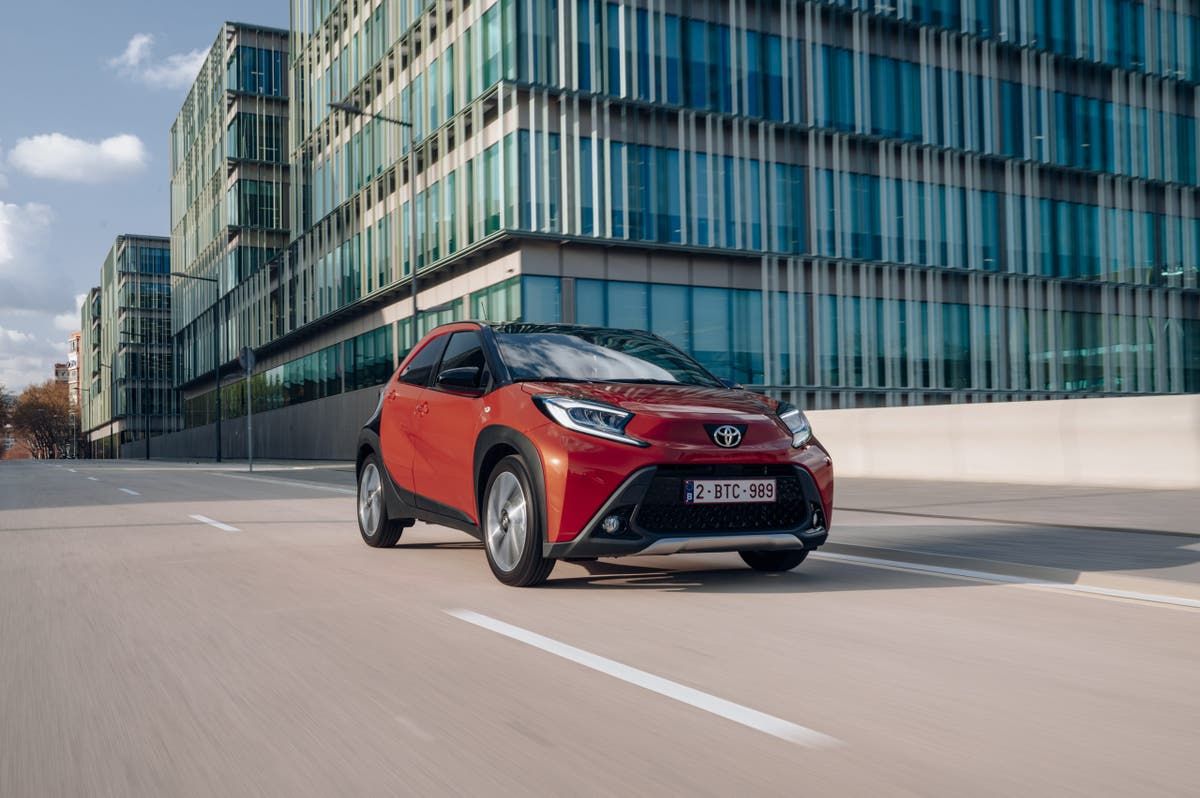tAlthough Toyota's feisty little Aygo Get past the zigzag styling and bold two-tone paint job and what you have before you is a fairly traditional city car or supermini, with the kind of spec you'd have a generation or so ago.
There is the five-speed manual gearbox. Some painted steel interior panels. A window in the back that opens. A tailgate that is actually nothing more than an opening window, albeit with an elegant opaque black finish. Under the hood we find a one-liter three-cylinder engine, without even a mild hybrid boost, let alone electric propulsion. There's only room for four, and that's a push, and there's not much room in the boot.
As for performance, well, it may feel quite agile and lively on the move and fortunately I was a little surprised to see the spec sheet that rates the Aygo X with a top speed of 150 km/h and a sprint from rest to 100 km/h. in a tedious 14.9 seconds. It is not a particularly “torque” engine, so you have to accelerate and work with the gear lever to make enough progress on the highway.
This is all good, because if you're prepared to put up with some minor inconveniences and adjust expectations, you'll find that the Aygo
Partly to test the idea that a modern city car is capable enough for a longer run, I managed to cover about 1,000 kilometers in my week with the car, and with few complaints. The seats were fine and, as the sole occupant, everything in the way of acceleration was available.
Higher-spec versions of the Aygo X are equipped with adaptive cruise control, including lane assist, and that makes a big difference to its long-distance capability. It also works well with the manual transmission. The bonus is 70+ mph running, with very little discomfort. Again, the “Exclusive” trim levels come with a very good stereo, which overcomes the noise at high speed.
The ride can be a little jittery on those stretches of concrete surface you still sometimes encounter, and I found the heating quite poor by modern standards, but if you turn it up enough you can be reasonably comfortable on a cold night.
THE SPECIFICATION
Toyota Aygo X Exclusive
Price: £18,275 (as tested; range from £16,130)
Engine capacity: 1.0 l petrol, 3 cylinders, 5-speed manual (automatic optional)
Power (CV): 71
Maximum speed (mph): 98
0-60 (seconds): 14.9
Fuel economy (mpg): 56.5
CO2 emissions (WLTP, g/km): 110
The X version of the Aygo, I should explain, is really just a cosmetic job on the standard Aygo city car, with a slightly raised ride height and thick cladding around the body. Obviously, it won't work properly off-road (front-wheel drive only), but in my experience, a muddy corral is easily passable.
It's often unfair (though fun) to review a car by standards it was never designed for (like putting a wardrobe in the back of a Lamborghini Huracan or trying to beat the Nurburgring record in a Transit van), but with city cars We can know that they must have the stamina to tackle occasional, larger tasks. The Aygo passed that test. If you want more fun, you can opt for one with a full-length canvas roof, a kind of convertible.
Unfortunately, cars like this are disappearing. For example, you may remember that early Aygo models had almost identical Citroën C1 and Peugeot 108 siblings, and virtually every major manufacturer had some offering in the field. But, as the old saying goes, minicars make miniprofits, and consumer safety demands, fashion, and space expectations have increased automobile “inflation,” so today a midsize SUV , close to two tons, is considered “compact” and ideal urban transportation.
Great models like the original Ford Ka (apart from endemic corrosion), the Smart and the Renault Twingo have disappeared. Battery electric cars are also better suited to a larger “footprint” and higher stance (the 45km/h Citroen Ami quadricycle is an exception). “Small” is no longer pretty.
So we should applaud and appreciate the Aygo, which probably only makes a financial case for itself because it's based on the larger, higher-volume Yaris. The Aygo is a bit pricey compared to its relatively few competitors: Fiat 500 hybrid, Hyundai i10, VW Up! and Kia Picanto (soon to be reviewed), but it's well made and, if cared for by a typically conscientious Toyota dealer, you'll enjoy an effective 10-year/100,000-mile warranty with no issues or rot.
And, for those who grew up with Fiat 127s and Vauxhall Vivas, that's definitely not old school.












